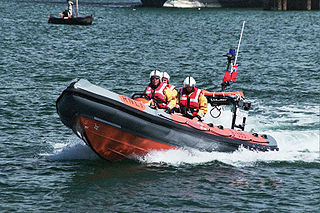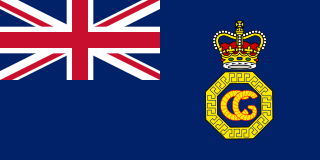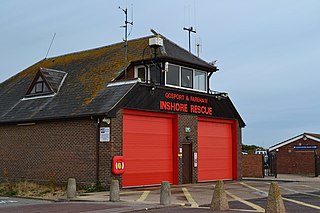
A rigid inflatable boat (RIB), also rigid-hull inflatable boat or rigid-hulled inflatable boat (RHIB), is a lightweight but high-performance and high-capacity unsinkable boat constructed with a rigid hull bottom joined to side-forming air tubes that are inflated with air to a high pressure so as to give the sides resilient rigidity along the boat's topsides. The design is stable, light, fast and seaworthy. The inflated collar acts as a life jacket, ensuring that the vessel retains its buoyancy, even if the boat is taking on water. The RIB is an evolutionary development of the inflatable boat with a rubberized fabric bottom that is stiffened with flat boards within the collar to form the deck or floor of the boat.

Her Majesty's Coastguard (HMCG) is a section of the Maritime and Coastguard Agency responsible, through the Secretary of State for Transport to Parliament, for the initiation and co-ordination of all maritime search and rescue (SAR) within the UK Maritime Search and Rescue Region. This includes the mobilisation, organisation and tasking of adequate resources to respond to persons either in distress at sea, or to persons at risk of injury or death on the cliffs or shoreline of the United Kingdom. It is also responsible for land based search and rescue helicopter operations from 2015.

The E-class lifeboat forms part of the RNLI fleet in the United Kingdom, operating exclusively in the tidal reach of the River Thames in London. The class was introduced in 2002 to serve the tidal reach of the River Thames, which had not previously been covered by an RNLI rescue service, as a result of a much delayed enquiry into the Marchioness disaster in 1989, in which 51 people died. The enquiry criticised the lack of a rescue service for the tidal Thames, and the UK government asked the Maritime and Coastguard Agency, the Port of London Authority and the RNLI to work together to set up a dedicated Search and Rescue service for this stretch of the river.

The Atlantic 85 is part of the B-class of lifeboats that serve the shores of the United Kingdom and Ireland as a part of the RNLI inshore fleet.

City of York was a 1,194 ton iron ship which sank after hitting a reef off Rottnest Island in the last few kilometres of its voyage from San Francisco to Fremantle, Western Australia in 1899.

Blyth Lifeboat Station is operated by the Royal National Lifeboat Institution and currently operates a D Class (IB1) "Jennie B".
The Royal New Zealand Coastguard is the primary civilian marine search and rescue organisation for New Zealand. Unlike a number of other countries, the organisation is a non-governmental, civilian charitable organisation, with no enforcement powers. Uniformed agencies of the New Zealand government, including the police, Maritime New Zealand and customs, manage New Zealand's maritime law enforcement and border control. Coastguard New Zealand has a strong focus on boating education.
A rescue lifeboat is a boat rescue craft which is used to attend a vessel in distress, or its survivors, to rescue crew and passengers. It can be hand pulled, sail powered or powered by an engine. Lifeboats may be rigid, inflatable or rigid-inflatable combination-hulled vessels.

Cromer Lifeboat Station is an RNLI station located in the town of Cromer in the English county of Norfolk. The station operates two lifeboats - one for inshore work and the other for offshore work.

RNLB Lloyds II was an Oakley-class lifeboat of the Royal National Lifeboat Institution (RNLI) stationed at Sheringham in the English county of Norfolk from 8 October 1990 until April 1992, when she was replaced by the Atlantic 75 second generation Rigid Inflatable Boat (RIB) Manchester Unity of Oddfellows in April 1992. During the time that the Lloyds II was on station at Sheringham, she performed 13 service launches.

Mundesley Volunteer Inshore Lifeboat is a voluntary run lifeboat station located in the village of Mundesley in the English county of Norfolk. The station operates one lifeboat which is used for inshore work. The lifeboat service is a "Declared Facility"; this means that H.M. Coastguard regard it as being on a par with the RNLI. The lifeboat provides its service 24 hours a day, 365 days a year to windsurfers, fishing boats, swimmers and divers or anybody in distress within the Mundesley area. The service has also provided assistance to boats of various sizes which have required towing etc.

Gosport Lifeboat Station is a volunteer-operated independent lifeboat station charity located in the village of Alverstoke on the peninsula of Gosport in the English county of Hampshire. Owned and operated by Gosport and Fareham Inshore Rescue Service (GAFIRS), it operates free lifeboat services in the Solent from Portsmouth Harbour to Titchfield Haven, on the approaching shores of Southampton Water. GAFIRS is a charity registered in England and Wales (1159681).

Penlee Lifeboat Station is the base for Royal National Lifeboat Institution (RNLI) search and rescue operations for Mount's Bay in Cornwall, United Kingdom. The lifeboat station operated at various locations in Penzance from the early 19th century. It moved to Penlee Point near Mousehole in 1913, thus gaining its current name, but was moved to Newlyn in 1983 without any change of name. The station is remembered for the loss of the entire lifeboat crew on 19 December 1981.

Palling Volunteer Rescue Service was originally an independent, voluntary-manned and charitably-funded inshore rescue service located in the village of Sea Palling in North Norfolk, England. First established by private funds in 1840, it was taken over by the Royal National Lifeboat Institution (RNLI) in 1858 and operated until 1931, when it was closed in a rationalisation of regional lifeboat stations. Revived in 1974 by local people through monies raised from private, business and charitable donations, today the charitable Sea Palling Independent Lifeboat, runs a single 5.7-metre (19 ft) Ocean Pro RIB, an Arancia ILB and a shoreline rescue quad bike, all covering the area between Eccles-on-Sea and Winterton-on-Sea.

Jersey Coastguard is responsible for the safety of life at sea along with the security and protection of the maritime environment for Jersey’s territorial waters. The service is provided by the Ports of Jersey from the Maritime Operations Centre in Maritime House in the port of St Helier, Jersey.

Yarmouth Lifeboat station is an RNLI station located in the town of Yarmouth on the Isle of Wight in the United Kingdom. The station has been based in Yarmouth's harbour since 1924. Previously the station had been in Totland Bay, west of Yarmouth, until it was decided that the station need a motor lifeboat. The current Severn-class lifeboat is moored afloat and shore facilities are on the quayside in Yarmouth. The station covers the western Solent with its all-weather lifeboat Eric and Susan Hiscock (Wanderer) (ON-1249) which has been on service at Yarmouth since 2001.

Happisburgh Lifeboat Station is a Royal National Lifeboat Institution (RNLI) Inshore lifeboat station close to the village of Happisburgh in the English county of Norfolk in the United Kingdom. Since 2003 the station boathouse has been re-located from the village to an area south called Cart Gap. This is because the beach below Happisburgh disappeared due to coastal erosion and the stations slipway and access was washed away. The original boathouse in the village is now used for training. There are currently two inshore lifeboats station at Happisburgh, an Atlantic 75-class inshore lifeboat called Friendly Forrester II (B-710) and a D-class inshore lifeboat called Spirit of Berkhamsted (D-607)

Eastbourne Lifeboat Station is a Royal National Lifeboat Institution (RNLI) lifeboat station in the town of Eastbourne in East Sussex. Founded two years before the RNLI was established, the station has operated continuously since 1822 and its lifeboats have been responsible for saving over 700 lives. There are two active lifeboat stations in Eastbourne, an all-weather station with the Tamar-class lifeboatDiamond Jubilee at Sovereign Harbour and the D-class Lawrence and Percy Hobbs at the inshore lifeboat station a couple of miles to the west at Fisherman's Green. An older lifeboat station, west of Eastbourne Pier, is now used as an RNLI museum.
Independent lifeboat services in Britain and Ireland began to be established around the coasts towards the end of the 18th century in response to the loss of life at sea. More recently, independent services have been set up in response to the increasing popularity of coastal and river sport and leisure activities.

Hope Cove Life Boat was formed in 1878 and is a voluntary search and rescue service that operates an inshore rescue boat in the Bigbury Bay area.

















